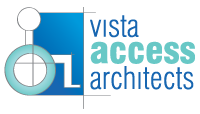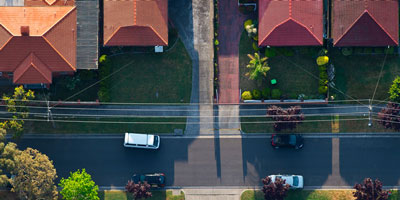AS 4299 - Adaptable Housing
An adaptable housing unit is a residential unit that is designed in such a way that it can be modified easily when required in the future to become accessible to the resident with disabilities without requiring costly and intensive alterations.
Most NSW based Council DCPs (Development Control Plans) require a percentage of the residential units in the development to be provided as Adaptable units, designed as per the requirements of AS4299- Adaptable Housing. The DCP will also state the classification level of Adaptability required. There are 3 Classification levels for Adaptable Housing:
Adaptable Class A in which all 119 essential and all desirable features are to be incorporated.
Adaptable Class B in which all essential and 50% of 64 available desirable features are to be incorporated
Adaptable Class C in which all essential features are to be incorporated (most basic level)
Below are the steps to design an Adaptable housing unit Class C level:
1. Main entry door, the door to the adaptable bedroom and the door to the adaptable bathroom is required to provide for 850mm clear opening space with circulation spaces as per AS1428.1-2009 determined by the direction of approach. Some typical door circulation spaces are shown below.
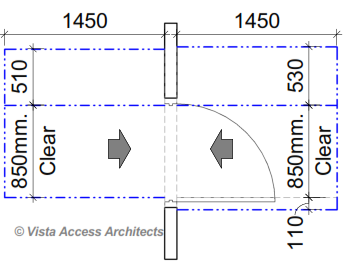
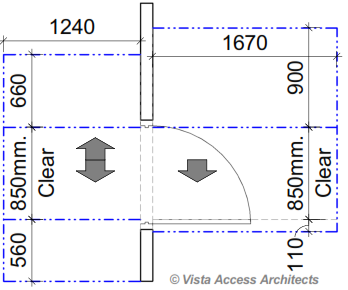 Encroachments within the door circulation spaces by easily removable cabinetry is permitted as long as the post adaptation drawings can demonstrate the same.
Encroachments within the door circulation spaces by easily removable cabinetry is permitted as long as the post adaptation drawings can demonstrate the same.
2. Any one bathroom is required to have circulation spaces as per AS1428.1-2009. Some examples are shown below.
The walls of the bathroom have to be in the same location at both pre and post adaptation. Internal layout (fixture locations) can change between pre and post adaptation, as long as the service pipes (waste and water supply pipes) are laid in the correct AS1428.1-2009 specified position at pre-adaptation itself and the services are capped off for future use.
In some cases, internal wall between 2 back-to-back bathrooms can be removed to allow for a larger bathroom at post adaptation.
Some examples of layouts for accessible bathrooms are shown below. Note that shower seats are not required for Adaptable units. Mirror images will also comply with requirements. Allow for construction tolerances as the below are finished dimensions.

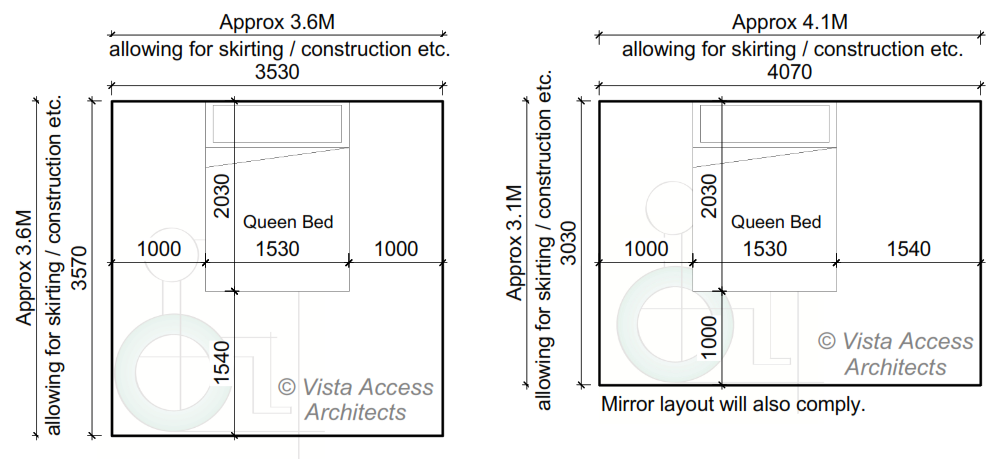
3. Laundry is to have a circulation space of 1550mm in front of appliances. If required, easily removable cabinetry can be relocated at post-adapation to achieved this space.
4. Kitchen is to be able to demonstrate 1550mm circulation space between benchtops in post adaptation layouts.
5. Internal Doorways – Door to main bathroom, main bedroom, laundry are required to be provided with 850mm clear opening with door circulation spaces as per AS1428.1
Remainder doors to be provided with 820mm clear opening.
6. Any one Bedroom to have circulation spaces around a Queen size bed with 1540mm space on any one side and 1000mm space on the other two sides of the bed.
7. All passageways to provide for 1M clear width when measured from skirting to skirting.
8. Parking – One 3.8M wide parking space or AS2890.6 compliant (2.4M wide with 2.4M wide shared zone) to be provided.
CLICK HERE to download 'Adaptable Unit requirements for Sydney LGAs'
Note that the AS4299 Adaptable Housing Standard has not been updated since 1995 and therefore the above steps to design adaptable units are based on more current standards (AS1428.1-2009) and industry practice. This advice may vary from consultant to consultant.
All drawings are copyrighted information of Vista Access Architects and distribution without written authorisation is prohibited.
